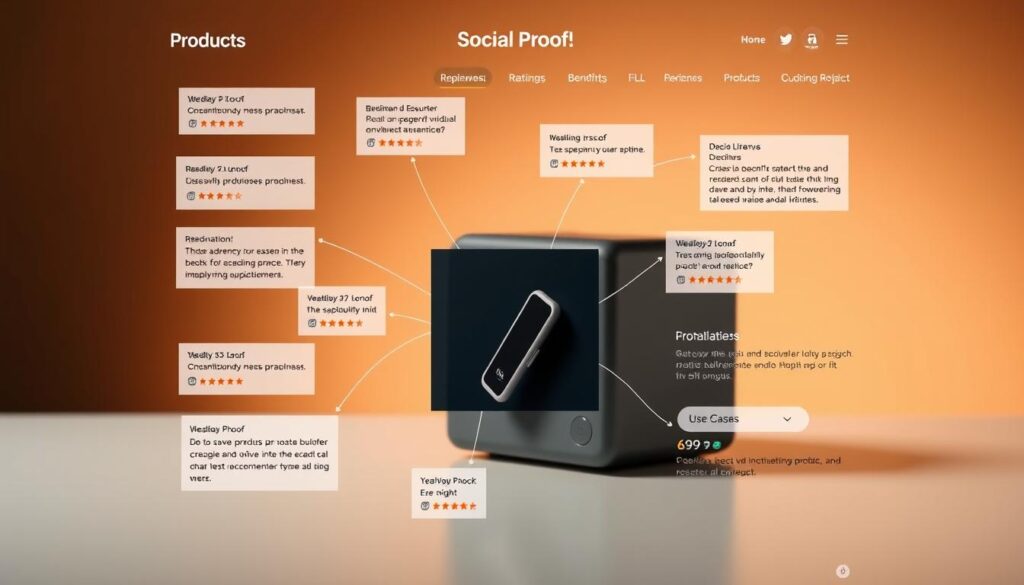In the competitive world of online retail, a well-crafted product description can be the difference between a sale and a missed opportunity. Effective descriptions not only inform customers about the product but also persuade them to make a purchase.
By transforming casual browsers into committed buyers, strategic and persuasive content can significantly boost an online store’s conversion rate. The right words can enhance the perceived value of products, making customers happy to pay more.
Key Takeaways
- Crafting compelling product descriptions to drive sales and increase conversion rates.
- Understanding the critical role of product descriptions in the customer journey.
- Using strategic content to differentiate products in crowded marketplaces.
- Optimising product descriptions for search engines and customer needs.
- Enhancing the overall customer experience through well-written descriptions.
The Power of Product Descriptions in E-commerce
The power of product descriptions in e-commerce is undeniable, driving sales and enhancing customer satisfaction. A well-crafted product description can significantly impact a brand’s reputation and bottom line.
Why Product Descriptions Matter
Product descriptions matter because they serve as a crucial touchpoint between the customer and the product. They provide customers with the information they need to make informed purchasing decisions. By highlighting a product’s features and benefits, descriptions help buyers understand how the product will meet their needs.
- Inform customers about product details, such as specifications and functionality.
- Persuade customers by highlighting the product’s value and unique selling points.
- Address common customer objections, removing barriers to purchase.
The Dual Purpose: Inform and Persuade
A product description performs a dual purpose: it informs customers about the product and persuades them to make a purchase. This dual purpose is critical in e-commerce, where customers rely on product descriptions to guide their buying decisions. By striking the right balance between providing factual information and crafting persuasive narratives, businesses can drive sales and enhance customer satisfaction.
Effective product descriptions guide customers through the decision-making process, moving them from consideration to conversion. Different products and stages of the buyer’s journey may require varying balances of informative and persuasive content.
Understanding Your Target Audience
The key to writing effective product descriptions lies in knowing your target audience inside out. When writing product descriptions for your ecommerce business, start by visualising your ideal customer.
What kind of tone do they appreciate? What vocabulary are they familiar with? Are there certain words they dislike? What questions might they have? Think about how you would communicate with your ideal customer if you were selling your product face-to-face in a physical store.
Identifying Your Ideal Customer
Identifying your ideal customer is crucial for crafting product descriptions that resonate with them. This involves understanding their needs, preferences, and pain points. By doing so, you can tailor your descriptions to speak directly to them, increasing the likelihood of a sale.
Effective customer research is key to uncovering the primary frustrations, challenges, and unmet needs that drive purchasing decisions in your market. As Philip Kotler once said, “Marketing is about meeting the customer where they are.”
“The aim of marketing is to know and understand the customer so well the product or service fits him and sells itself.”
Addressing Customer Pain Points and Desires
To master the art of writing compelling product descriptions, you need to identify and address specific customer pain points. This involves mapping product features directly to these pain points, creating clear connections between what you offer and what customers need.
- Conduct effective customer research to understand the primary frustrations and challenges.
- Map product features to pain points, creating clear connections.
- Balance addressing rational pain points with emotional desires.
By understanding and addressing the needs and desires of your target audience, you can create product descriptions that not only inform but also persuade, driving sales and enhancing customer experience.
Crafting Your Brand Voice and Tone
Developing a distinctive brand voice and tone is crucial for creating product descriptions that resonate with your target audience. Your brand’s voice and tone are not just elements of your marketing strategy; they are critical components that can make or break the effectiveness of your product descriptions.
As highlighted by various brands, the voice and tone can vary significantly. For instance, Cards Against Humanity is known for its edgy and humorous tone, while Felix Gray adopts a more reserved and refined approach. Jeni’s ice cream, on the other hand, is warm and friendly, much like a close friend. The key to determining the “right” voice and tone for your product descriptions lies in understanding two crucial factors: your ideal prospect and your brand identity.
Defining Your Unique Brand Voice
Your brand voice is the personality of your brand, expressed through the language and tone used in your communications. To define your unique brand voice, you need to consider what impression you want to make on your customers and how you want to be perceived. Are you friendly and approachable, or professional and authoritative? Your brand voice should be consistent across all your marketing channels, including your product descriptions.
As
“The right brand voice can make your product descriptions more relatable and engaging, ultimately driving customer loyalty and conversion rates.”
Consistency in brand voice helps in building a strong brand identity that customers can recognize and trust.
Adapting Tone to Product and Audience
While your brand voice remains consistent, the tone can be adapted based on the product category, price point, and the emotional context of the purchase decision. For instance, the tone used for a luxury product might be more sophisticated and elegant, whereas a budget-friendly product might be described in a more casual and friendly tone.
- Master the art of adjusting your tone to resonate with different audience segments while maintaining a consistent brand voice.
- Learn to match your tone to the customer’s journey stage, using different approaches for awareness, consideration, and decision phases.
- Explore how seasonal variations and cultural moments can influence the tone of your product descriptions.
By understanding your target audience and adapting your tone accordingly, you can create product descriptions that are not only compelling but also relevant to your customers’ needs and preferences.
Highlighting Benefits Over Features
To craft product descriptions that convert, businesses must focus on the benefits that their products offer to customers. This approach shifts the emphasis from what the product is to what it can do for the customer, making it more relatable and desirable.

The Distinction Between Features and Benefits
Product features are the characteristics or attributes of a product, such as its design, materials, or technical specifications. On the other hand, benefits are the positive outcomes or advantages that customers gain from using the product. For instance, a feature might be that a smartphone has a waterproof coating, while the benefit is that it provides protection against accidental splashes or rain.
Understanding this distinction is crucial because customers are ultimately more interested in how a product will improve their lives rather than its technical specifications.
Transforming Features into Compelling Benefits
To effectively transform features into benefits, businesses can employ several strategies:
- Use the “so what?” technique to determine the practical implications of each feature for the customer.
- Apply the formula “This means that…” to directly link features to their benefits, making the value proposition clear.
- Prioritise benefits based on audience research to highlight the advantages that matter most to the target customers.
- Quantify benefits wherever possible, using specific numbers and outcomes to enhance credibility and impact.
- Utilise the Problem-Agitate-Solution (PAS) framework to structure benefit statements that resonate with customer pain points.
- Leverage customer testimonials and reviews to identify and highlight the benefits that actual users value most.
By focusing on benefits rather than just listing features, businesses can create product descriptions that are more engaging, persuasive, and customer-centric. This approach not only enhances the shopping experience but also drives sales by making the value proposition clear and compelling.
Effective E-commerce Product Descriptions Formats
Effective product description formats are essential for driving sales in e-commerce. The way information is presented on a product page can significantly influence a customer’s purchasing decision.
Paragraph and Bullet Point Combinations
Combining paragraphs with bullet points is a highly effective way to present product information. Paragraphs can provide a narrative that engages the customer, while bullet points offer a clear and concise summary of the product’s key features and benefits.
For instance, a product description might start with a paragraph that introduces the product and its unique selling proposition, followed by bullet points that highlight its main features.
Example of a Product Description:
- Product: Smart Wireless Headphones
- Description: Experience pure sound with our Smart Wireless Headphones.
| Feature | Benefit |
|---|---|
| Long Battery Life | Enjoy uninterrupted music for up to 24 hours |
| Noise Cancellation | Immerse yourself in pure sound without distractions |
| Water Resistance | Your headphones are protected against accidental splashes |
Structuring for Maximum Impact
Structuring product descriptions for maximum impact involves more than just the format; it’s about creating a logical flow that guides the customer through the information they need to make a purchasing decision.
Using subheadings, bold text, and other formatting elements can help create a clear hierarchy of information, making it easier for customers to scan and understand the product details.
By mastering the inverted pyramid structure, creating a logical flow, and using appropriate formatting elements, businesses can significantly enhance the effectiveness of their product descriptions.
Using Storytelling and Sensory Language
To truly captivate customers, e-commerce businesses must weave storytelling and sensory details into their product descriptions. By doing so, they can create an immersive experience that not only informs but also emotionally resonates with potential buyers.
Creating an Emotional Connection Through Stories
Storytelling is a powerful tool in e-commerce, allowing brands to connect with their customers on a deeper level. When a product description tells a story, it doesn’t just list features; it transports the customer into a scenario where they can experience the product’s benefits firsthand. For instance, describing a hiking boot doesn’t just involve listing its waterproofing and durability but also paints a picture of the adventures one can have while wearing it.
Using narratives that highlight the product’s origins, the craftsmanship behind it, or the problems it solves can create an emotional bond with the customer. This emotional connection can be a decisive factor in the purchasing decision, making the customer more likely to choose a product that resonates with them on a personal level.
Engaging the Senses with Descriptive Language
Sensory language is another crucial element in crafting compelling product descriptions. It involves using words that appeal to the customer’s senses, helping them imagine the product in their lives. For example, describing a luxury candle as emitting a “soft, golden glow” and a “subtle, soothing scent” of lavender can evoke a sensory experience, making the product more appealing.
To effectively use sensory language, businesses should consider the product category and tailor their descriptions accordingly. For textiles, this might involve describing the feel of the fabric; for food products, it could be about the taste and aroma. The goal is to create a multi-dimensional experience through words alone, bridging the gap between the online shopping experience and the physical interaction with the product.
By mastering the art of sensory language and storytelling, e-commerce businesses can enhance their product descriptions, making them more engaging and effective at driving sales. It’s about creating a vivid, immersive experience that not only showcases the product but also resonates with the customer’s emotions and senses.
Making Descriptions Scannable and Mobile-Friendly
As mobile devices dominate online shopping, the importance of scannable and mobile-friendly product descriptions cannot be overstated. With more than half of all e-commerce transactions now occurring on mobile devices, a poorly optimised product description can cost sales. If the text is hard to read, cluttered, or requires endless scrolling, shoppers are likely to bounce before making a purchase.
Formatting for Easy Reading
To keep mobile users engaged, it is essential to follow best practices for mobile-friendly descriptions. This includes keeping the content concise, as mobile screens have limited space, making short, engaging sentences the most effective. Using bullet points for key details is also crucial, as it makes information easy to scan quickly. Additionally, breaking up text with bolded highlights can draw attention to important benefits, enhancing the overall user experience.
For instance, when describing a product, instead of using lengthy paragraphs, businesses can use a combination of short sentences and bullet points to highlight key features and benefits. This approach not only improves readability but also helps in retaining the customer’s attention.
Optimising for Mobile Devices
Optimising product descriptions for mobile devices involves several key strategies. Ensuring fast loading times is critical, as heavy images or long-winded copy can slow down the experience, deterring potential customers. By prioritising information and using progressive disclosure techniques like expandable sections, businesses can provide comprehensive information without overwhelming mobile users.
Best practices for typography on mobile devices, including appropriate font size, line spacing, and contrast ratios, are also vital to ensure readability. Testing product descriptions across different devices and screen sizes is necessary to ensure a consistent, user-friendly experience for all shoppers. For more insights on e-commerce product description best practices, visit https://www.airops.com/blog/e-commerce-product-description-best-practices.
| Optimisation Technique | Description | Benefit |
|---|---|---|
| Concise Content | Keep sentences short and engaging | Improves readability on small screens |
| Bullet Points | Use for key details and features | Makes information easy to scan |
| Bolded Highlights | Break up text to draw attention | Enhances user experience by highlighting benefits |
Incorporating Social Proof and Trust Signals
The inclusion of social proof and trust signals in product descriptions is a key strategy for building customer trust and driving sales. By leveraging the experiences and opinions of others, businesses can create a sense of credibility and reliability around their products.

Leveraging Customer Reviews and Testimonials
Customer reviews and testimonials are powerful forms of social proof that can significantly influence purchasing decisions. They provide potential customers with firsthand accounts of a product’s performance and value. For instance, a study found that 85% of people trust online reviews as much as personal recommendations. To effectively leverage customer reviews, businesses should showcase them prominently on their product pages, along with ratings and feedback.
For more insights on creating effective product descriptions, visit this article on crafting SEO-friendly product descriptions.
Adding Credibility with Facts and Statistics
In addition to customer reviews, incorporating facts and statistics into product descriptions can further enhance credibility. By substantiating claims with data, businesses can build trust with potential customers and differentiate their products from competitors. For example, a table comparing product performance metrics can help illustrate a product’s advantages.
| Product Feature | Our Product | Competitor’s Product |
|---|---|---|
| Battery Life | Up to 12 hours | Up to 8 hours |
| Water Resistance | IP68 | IP67 |
| Customer Support | 24/7 Dedicated Support | Limited Support |
By combining social proof, customer testimonials, and factual evidence, businesses can create compelling product descriptions that drive sales and build customer loyalty.
Optimising Product Descriptions for SEO
To enhance their online presence, e-commerce businesses must focus on optimising their product descriptions. This involves striking a balance between creating engaging content for customers and ensuring that search engines can understand and index the page effectively.
Effective SEO begins with thorough keyword research. By identifying the terms and phrases potential customers use when searching for products like theirs, businesses can tailor their descriptions to match these queries. This doesn’t mean simply stuffing the content with keywords; rather, it’s about naturally incorporating relevant terms to improve visibility.
Keyword Research and Implementation
Conducting keyword research is the first step in optimising product descriptions. Tools like Google Keyword Planner, Ahrefs, or SEMrush can help identify relevant keywords. Once identified, these keywords should be implemented naturally throughout the description, ensuring it remains readable and engaging.
For instance, if a product is a “handmade leather wallet,” the description might include phrases like “unique leather craftsmanship” or “durable wallet for men.” This not only aids in search engine ranking but also provides potential customers with the information they’re seeking.
| Keyword | Search Volume | Competition |
|---|---|---|
| handmade leather wallet | 1000 | High |
| unique leather craftsmanship | 500 | Medium |
| durable wallet for men | 800 | High |
Avoiding Keyword Stuffing and Duplicate Content
While keywords are crucial, it’s equally important to avoid keyword stuffing. This practice, where keywords are excessively used, can lead to penalties from search engines and a poor user experience. Similarly, using duplicate content across multiple product pages can dilute SEO efforts.
To avoid these pitfalls, businesses should focus on creating unique, high-quality descriptions. Even when selling products supplied by manufacturers, there are ways to add a unique spin. For example, describing how the product is used in different scenarios or highlighting customer testimonials can add originality.
By balancing SEO best practices with the need to drive sales, e-commerce businesses can create product descriptions that not only rank well in search engines but also resonate with their target audience.
Common Product Description Mistakes to Avoid
The art of writing product descriptions that drive sales is often overlooked, with many online stores listing features and calling it a day. While clear information about products is essential, it’s equally important to tell potential customers how a product can help them. Let’s examine some common pitfalls in product description writing and how to avoid them.
Overly Generic or Vague Descriptions
One of the most significant mistakes in product description writing is being too generic or vague. Descriptions that lack specificity fail to provide customers with the information they need to make informed purchasing decisions. To avoid this, focus on the unique aspects of your product and highlight what sets it apart from similar products.
For instance, instead of saying “this shirt is comfortable,” say “this shirt features a soft, breathable fabric that ensures all-day comfort.” By being more descriptive, you can help customers understand the value proposition of your product.
Focusing Solely on Features
Another common mistake is focusing solely on the features of a product without explaining how those features translate into benefits for the customer. While features are important, customers are ultimately more interested in how a product will improve their lives. To avoid this pitfall, use the “So what?” technique to transform features into compelling benefit statements.
For example, if a product has a feature like “water-resistant coating,” the benefit statement could be “stay protected from the elements with our water-resistant coating, ensuring your device remains functional even in harsh weather conditions.” By highlighting the benefits, you can create a more engaging and persuasive product description.
By avoiding these common mistakes, businesses can create product descriptions that not only inform but also inspire customers to make a purchase. It’s about striking the right balance between providing necessary information and persuading potential buyers.
Testing and Measuring Product Description Performance
The success of product descriptions in driving sales can be measured by tracking key performance indicators on product pages. To understand whether these descriptions are convincing shoppers to buy, it’s essential to monitor their performance.
Several key performance indicators (KPIs) can indicate the effectiveness of product descriptions. These include conversion rate, cart abandonment rate, return rate, and support inquiries. A high conversion rate suggests that the descriptions are effective, while a high cart abandonment rate may indicate that the descriptions or checkout process need improvement.
To maximise the effectiveness of product descriptions, continuous testing and optimisation are crucial. This involves establishing baseline metrics, such as conversion rates and time on page, and using testing methodologies like A/B testing and multivariate testing to identify what resonates best with the audience.
| Metric | Description | Implication for Product Descriptions |
|---|---|---|
| Conversion Rate | Percentage of visitors who make a purchase | High conversion rate indicates effective descriptions |
| Cart Abandonment Rate | Percentage of shoppers who leave without buying | High rate may indicate issues with descriptions or checkout |
| Return Rate | Percentage of products returned | High return rate may indicate inaccurate descriptions or images |
By analysing these metrics and testing different elements of product descriptions, such as headlines and call-to-action phrases, businesses can refine their approach to improve sales performance. Using tools like heat mapping and scroll depth analysis can also provide insights into how customers interact with product pages.
Conclusion
The art of writing product descriptions that sell is a crucial element in the success of any e-commerce business. By shifting from facts to feelings, you create a description that does more than describe — it sells. A great product description makes shoppers feel what it’s like to use the product, bringing it to life with sensory words.
To maximise their effectiveness, it’s essential to recognise that compelling product descriptions are not just nice-to-have but essential components of a successful online store. They serve multiple purposes: informing customers, persuading them to buy, differentiating your products, and improving search visibility.
By focusing on benefits rather than features, addressing customer needs, and committing to ongoing testing and optimisation, businesses can significantly enhance their product descriptions. This approach not only improves conversion rates and customer satisfaction but also provides a high return on investment. Make sure to audit your current descriptions against best practices and identify opportunities for immediate improvement to drive sales and growth.






